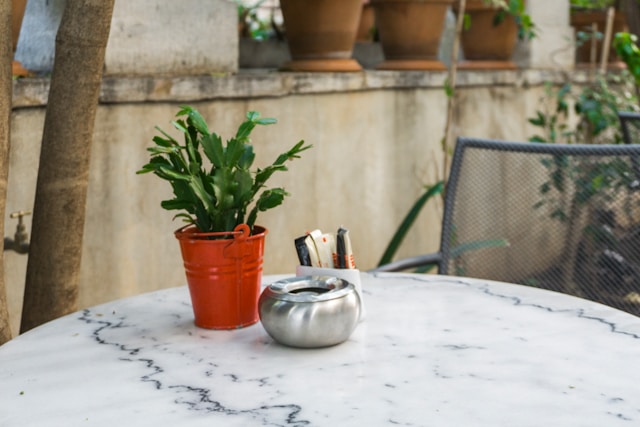Table of Contents:
- Introduction
- Understanding Marble’s Unique Properties
- Daily Care Tips for Marble Surfaces
- The Fundamentals of Marble Polishing
- Professional Versus DIY Marble Care
- The Science Behind Marble Stain Removal
- Long-term Maintenance Strategies for Marble
- Troubleshooting Common Marble Problems
- The Environmental Impact of Marble Care
- Advancements in Marble Care Technology
- Conclusion
Key Takeaways:
- Understanding marble’s unique requirements is crucial for effective maintenance.
- Regular cleaning and proper spill management can prevent most surface damage.
- Professional services offer advanced care for therapeutic and intricate work.
- Advancements in technology streamline marble maintenance and contribute to sustainability.
Using marble for countertops, flooring, and architectural decoration spans thousands of years, showcasing a legacy of luxury and refinement in ancient and modern designs. These opulent surfaces often become the centerpiece of any room they adorn and require specialized care. The demand for professional marble care is paramount in bustling urban areas like Manhattan. For example, elegant marble countertops Manhattan NY, can retain their gleaming appearance only with meticulous maintenance. This article provides insights into the maintenance practices necessary to preserve marble’s luster, drawing on professional expertise and the latest advancements in marble care.
Understanding Marble’s Unique Properties
Marble’s journey begins deep within the Earth’s crust, where limestone transforms intense heat and pressure, crystallizing to form the distinctive veined patterns that marble is known for. Its beauty and array of colors make it highly sought after for decorative purposes; however, marble’s calcite composition leaves it vulnerable to environmental factors. It can be stained by acidic substances, such as vinegar or lemon juice, that seep into its porous structure, leading to dull spots known as etches. The softness of the stone also leaves it at risk for scratches and nicks, which is why an understanding of its geological makeup is essential in crafting a dedicated care regimen.
Daily Care Tips for Marble Surfaces
Maintaining the luster of marble surfaces begins with day-to-day upkeep. For regular cleaning, a non-abrasive, pH-neutral cleaner should be used along with a soft cloth, as rough sponges can scratch the marble’s surface. It’s also prudent to blot up spills immediately—especially those from acidic substances—to prevent staining. While marble is durable, it requires gentle handling. Never use vinegar, lemon juice, or other acidic cleaners that can damage, rather than maintain, its pristine condition. Adopting a routine cleaning schedule will keep your marble countertops and surfaces resistant to most damage they are likely to encounter.
The Fundamentals of Marble Polishing
Even with regular maintenance, marble can lose its sheen over time, becoming dull and lifeless. This is where polishing can play a significant role in revitalizing its appearance. Polishing marble is a multistep process involving grinding the surface with progressively finer abrasive pads, culminating in a high-polish finish. A polished marble surface not only looks better, but it’s also more resistant to the penetration of moisture and stains. Whether homeowners choose to polish marble themselves or hire professionals, it is imperative to use the right products and techniques to protect and enhance the natural beauty of the stone.
Professional Versus DIY Marble Care
When it comes to maintaining the integrity of marble surfaces, there often needs to be more clarity between the efficacy of DIY methods and the necessity of professional services. The key is understanding the scope of the task at hand. Simple cleaning and minor polishing jobs can often be handled at home with the right tools and knowledge. Yet, professional expertise is invaluable for restoring marble that has suffered significant wear or damage or for undertaking the complex task of restoring antique marble pieces. Professionals possess specialized tools, industrial-grade products, and refined techniques shaped by years of experience.
The Science Behind Marble Stain Removal
The battle against stains on marble surfaces can be fought with science. Marble is particularly reactive to acidic solutions that cause discoloration or etching. Knowing the type of stain—organic, inorganic, or oil-based—is crucial to choosing the proper removal method. Organic stains may fade naturally over time, while others will need a carefully applied poultice containing a relevant chemical to draw out the stain. This process can be delicate, so understanding the chemistry behind the various stains is essential for safe and effective stain removal.
Long-term Maintenance Strategies for Marble
Consistent upkeep is the key to preserving marble in the long term. This includes periodic sealing of the surfaces to create a protective barrier against potential staining agents. Also, regular reevaluation of the marble’s condition will help anticipate the need for professional services before minor blemishes become significant problems. This preventative approach to marble maintenance not only maintains the beauty of the surface but also contributes to cost savings over time, as consistently cared-for marble is less likely to require restoration or extensive repair.
Troubleshooting Common Marble Problems
Even with the best care, marble can still encounter issues. Identifying and troubleshooting common problems such as etch marks, chips, or cracks are part of a well-rounded maintenance strategy. For instance, shallow scratches may be buffed out, and small chips can be filled with a matching stone adhesive. However, for more severe damage, it’s usually advisable to consult a professional who can skillfully repair the marble without further compromising the integrity of the stone.
The Environmental Impact of Marble Care
Sustainability is becoming increasingly central in the field of stone maintenance. Green marble care practices not only prolong the life of the natural resources but also promote a healthier living environment—a notable concern for many. Non-toxic, biodegradable products and reduced waste practices are examples of how the marble care industry is adapting to be more environmentally friendly.
Advancements in Marble Care Technology
The marble industry needs to stand still in terms of innovation and progress in maintenance techniques. Technological advancements continue to evolve, offering more efficient ways to clean, polish, and preserve marble surfaces. From diamond-infused pads for a more precise polish to enhanced sealants offering more robust protection, these developments provide new opportunities to keep marble looking its best with less effort. Staying informed about these new techniques ensures homeowners and professionals can adapt and optimize their maintenance routines for the best possible results.
Conclusion
The luxury and beauty that marble brings to any space cannot be overstated. However, achieving and maintaining this elegance is an endeavor that requires knowledge, dedication, and care. By employing the proper daily care and long-term maintenance strategies and leveraging professional services when necessary, the longevity and brilliance of marble can be sustained. Keeping abreast of technological advancements and following eco-friendly practices will also play a vital role in the future of marble care.
For more information on the geology of marble and current trends in care practices, explore the resources provided by the US Geological Survey and ScienceDaily, respectively.



